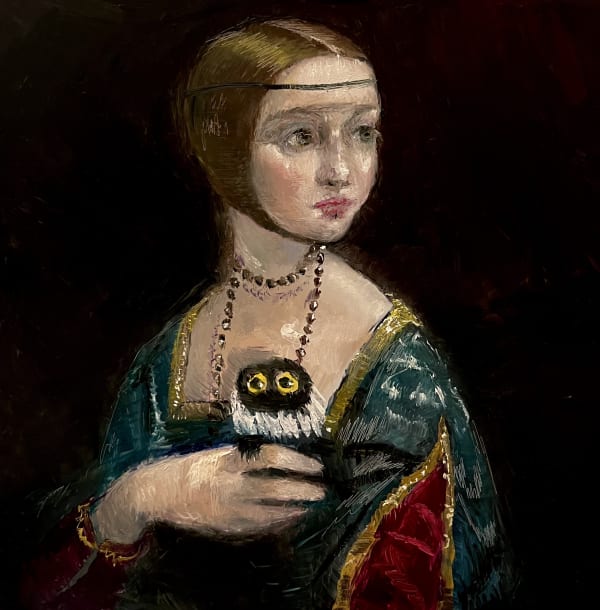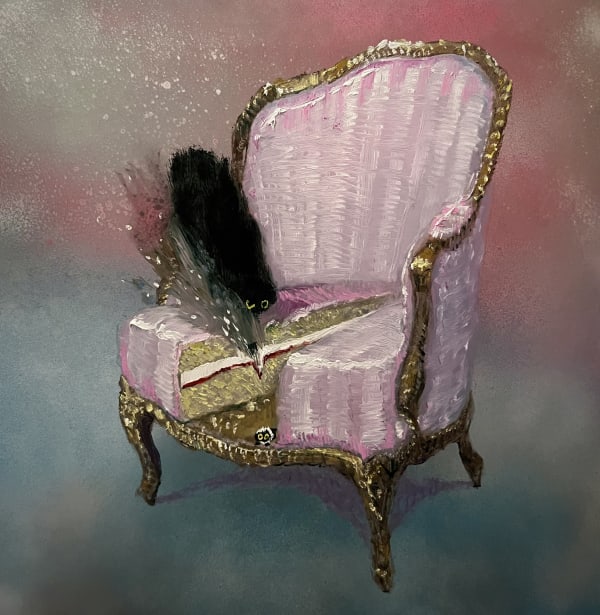One day I saw a rolled up black sock on the studio floor and I thought, that looks like a kitten. Of course, it wasn't, but that didn't matter. I gave that sock a name, a personality and decided to use him as an avatar. Kevin would travel back throughout history and have adventures wherever I, and he, felt like going.
How does the addition of "Kevin" alter the narrative of classical portraiture?
I liked the idea of paying homage to the masters, reiterating their importance in today’s visual world of short attention spanned social media influenced brains. It also gave me an excuse to copy the masters and learn and study their techniques.
How do you think Leonardo da Vinci would react to "Kevin"?
I hope Leonardo Da Vinci would get over the shock, feel some empathy and refrain from using Kevin as a test pilot in one of his helicopters. He had no idea that Andy Warhol would give each of us fifteen minutes, let alone conceive of social media becoming the vector for all our indulgent selfie culture, but there’s no pretension here, just insight and beauty.
I noted that you prefer to paint from memory, instead of visual references. What memories inspired Sleeping with the Enemy?
The idea of a beautiful sleep that I have never had.
How did you develop the personalities of the cats?
They predominately have developed from the many people I have come across in my life. I find that they are a way of expressing the weird and wonderful personalities that exist around us.
As a teenager I had a couple of cats. One was a Manx, and she was not a nice cat, but I loved her like crazy. Later in life I met a couple more cats, just as diabolical, and similarly I clung onto, and stored away impressions I liked of their silliness, and ridiculous malice.
In my practice, I draw on these saved mirages of cats, and dogs, people, landscapes, art, literature, the natural world and often myself, and seek to pull some of the parts together in a painted work, like an existential Frankenstein.
How do you select your color palette?It really depends on how I feel that day. I just get started. If I don’t have a plan for the day I will just mess around with colours, turn the boards upside down and on their side, see if I can see anything. After a while, you fall into a trance and then the painting reveals itself. You basically form a mashup of the symbols and ideas you have worked with all your life. After a few hours you can see what you are trying to say but couldn’t find the words behind the emotion. The subconscious is like the deep web, its chock full of random information, painting can bring some of that information together to create personal stories.
What inspired you to transform a simple, domestic chair into a cake in Cake Chair?
Well it’s not because I’ve had any feeling towards eating chairs…. I do appreciate antique chairs and the beautiful fabrics that they are made from. I guess these bright colours and textured fabrics remind me of a well made and decorated cake.
I also love the opulence of carved furniture from the Baroque Period.
Cake imagery and its relation to a childlike nostalgia for happiness which may never be real, but rather imaginary, unattainable and unachievable. It’s been said “pain is inexhaustible, it’s only people who get exhausted…”
How does your childhood in the countryside of Australia influence your paintings?I grew up in a small country town called Wingham in Australia. It has a beautiful remnant rainforest. I was surrounded by the natural world and the occasional human. My parents deeply respected art and music, so I was surrounded by textiles, paintings and lots of books about painting.
Do you hope audiences have any particular response to your paintings?
One can never “have it all”, to be both the artist and patron. To intrinsically understand those things around us that others overlook is what we want from our artists, our creatives. They give voice to the profound mystery of the world around us, surrounded as we are with consumerism, pointless greed, deceit and dissatisfaction. There’s no pretension here in these paintings, just spontaneous insight and beauty. Some art is said to speak volumes, but these works are more like innocent and delicate poems, whispering untold truths with an economy of words.
I feel the combination of basically placing an emoji in to a copy of a classical painting makes it like a pop song. Sure, it also adds an element of cheek and we all need a few more positive things to look at. Look at the news, how are you supposed to stay in a sane mood if you take it all in? I feel I am sharing beauty and also paying respect to the masters by reintroducing them in the modern world.
More information about Vannesa's works please contact us at



